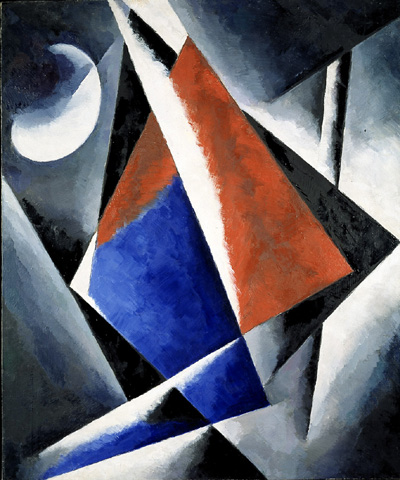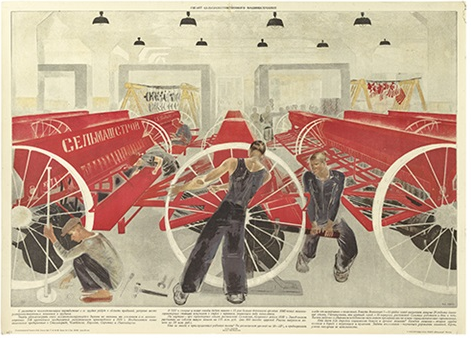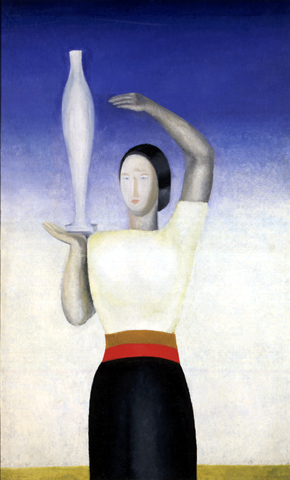“WOMENS’S ART” EXHIBITION
However, it is only in the dawn of the cubist movement that women find their full place in the artist community. The public opinion nevertheless stays reluctant, and a journalist in 1913 writes about an exhibition by Gontsharova: “It is disgusting that the female sex tries to become artistic. This is disturbing our society’s morality!” Indeed during this time the women turned the vocabulary of painting upside down, and the critics were forced to establish completely new criteria in judging all the cubofuturistic movement.

Liubov Popova, Construction, 1920, Oil on canvas, 106.8 x 88.7 cm
Liubov Popova (1889-1924), the founder of this current, together with Ekster, Stepanova and Gontsharova developed the language invented by Tatline, Malevitch and Kandinsky to new heights. These Amazons of the Avant-garde, as they were often called, were also questioning the established rules of life, asking for the rights of women to take the jobs they wanted, or, in the dawn of the first world-war, to become soldiers and fight for their country.

Ekaterina Zernova, A Giant of Agricultural Machine Building, 1931, Poster, 50.8 x 71.1 cm
After the time of departure tendencies during the early days of the socialistic revolution followed the long time of repression and state-dictated aesthetics. Nevertheless it is interesting to note how artists became biased between the official art that they had to produce and the unofficial one they wanted. Thus here in the exhibition a split between the Socialistic Realism and private paintings becomes visible. Where the official propaganda tried to level gender problematics and create a neutral art working for state goals, artists like Ekaterina Zernova or Brie-Bejn would paint tanks and proletarian appearances whereas others like Mavrena-Lebedeva would paint “for interior use only”. For them, of course, gender problematics just were marginal, as they focused on other views on life.

Anna Leporskaya, Woman with a Vase, 1934
With time passing, the borders of official art became wider. During the seventies and eighties, the so-called “time of thawing”, it was more or less possible to express oneself more freely. Artists now began to oppose the pompous soviet ceremonial style and also to work on the less attractive sides of life. A good example is the “Self-portrait with daughter” by Egorshina that doesn’t stand in the tradition of academies any more, or the “Composition” by Lydia Masterkova, who belonged to the so-called Soviet Underground.
Nowadays, after the end of the Soviet Union, artists are finally free to work as they please. To enter the contemporary part of the exhibition, one has to pass through Nasarenko’s installation “Perechod” (passageway) that transforms the museum corridor into a public subway entrance, complete with the mass of beggars, beer-drinkers and babushkas that are so ubiquitous in contemporary Russian life. A completely different view is offered by the grand-scale photographs “A Harder Life” by Panova, that despite their title only show enormous enlargements of kitchen utensils. A cunning look on recently revived religion is the installation “Annunciation” by Nachova. Using small ventilators to blow up red plastic angels and make breathe a white-clothed statue of the Virgin, she creates a new interpretation of the same picture by Jean Fouquet, changing the focus of the traditional biblical story to a critical look on female perception. Mary is just built of a hollow vessel that has no right to decide if she wants to receive or not, bringing to light the questionable character of a dominantly male religion like the Christian one. Questioning the museum as institution itself are the small photographs without title by Changsler, that only show themselves when touched.
They are covered with a chemical that only turns transparent when warmed up. On the contrary to normal museum practices that don’t allow physical contact with the works of art, this one even demands it – a new way of dealing with the idea of exhibitions itself.
One of the few video installations is “Suspense” by Salachova, a projection of a video of a pregnant woman on the wall, where it intersects with a painting of the same woman. It thus creates a hybrid object between the two media, the traditional as well as the modern one. At the end of the hall, we come not only to the end of the exhibition, but also to an ending in the chronology: Obuchova’s cloth objects “Embroidered Cinema” close the circle to the first objects of art from the 14th century that we saw in the beginning. Using old techniques to illustrate new phenomena, they create objects in between the times, making of the exhibition a palindrome to be read back and forth again and again.
Women’s Art
Date: March 1st – May 31st, 2002
Place: State Tretyakov Gallery
Address: 10 Krymsky Val, Moscow
Tel: +7 (0)95 238 1378
https://www.tretyakov.ru
Text: Natalia Volodina, Timo Linsenmaier
Images: Courtesy of Tretyakov Gallery




